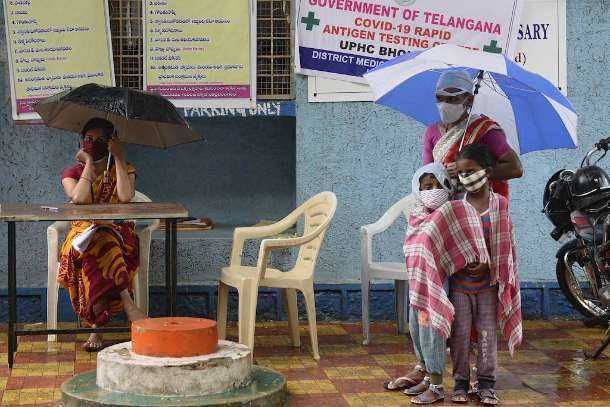
A woman with her children waits for the health workers to collect their swab samples to test for the Covid-19 coronavirus at a sample collection centre in Hyderabad on October 13, 2020. (Noah Seelam/ AFP)
The Covid-19 pandemic crisis and the economic collapse are aiding India's poverty to spiral up. The numbers speak for themselves. India's gross domestic product fell by 23.9 percent between April and June, in the first quarter of the Indian fiscal year.
India's is facing its worst economic downturn since 1996, when the current model of growth statistics was implemented. Even before the arrival of the coronavirus, the Indian economy was struggling. Economic growth fell from 8.2 percent in 2016-2017 to 4.2 percent in 2019-2020, reaching its lowest rate in 20 years.
Last year, even before the pandemic, experts warned that not enough jobs were being created to absorb young people entering the labor market. And then, the pandemic dealt a severe blow to the economic health of Asia's third-largest power.
Among the measures imposed to contain the epidemic was a three-month-long strict lockdown that started on March 25. The lockdown, one of the strictest in the world, weakened and impoverished the economy.
It did not, however, slow the spread of the epidemic. Today, India is the second most Covid-19 affected country globally, with more than 7 million cases. India has also surpassed the 100,000 marks of deaths related to Covid-19, after the United States and Brazil.
In the past few months, unemployment and poverty have also increased. With several million people are at risk of falling into poverty, the leap backward is unprecedented.
Prime Minister Narendra Modi, who was re-elected last year under his Hindu nationalist party's banner, gave 1.3 billion Indians four hours to prepare for it. For nearly 70 days, India was completely paralyzed, with transportation suspended, state borders closed and activity virtually halted. This shock hit the poorest first and hardest.
Exodus of day laborers
The lockdown has cost millions of jobs. Overnight, daily laborers were deprived of their source of employment in a country where the informal sector is king. The authorities have drastically neglected the fate of these vulnerable Indians. For several weeks, India was the scene of a real humanitarian crisis, with hundreds of migrants seeking to return to their native villages. Such population movements had not been observed since the partition of India in 1947.
Prime Minister Modi waited until May to announce a stimulus of US$287 billion to prevent the economy from failing. His critics then judged it late and unsuitable, given what is at stake.
The migrant day-laborers were only just one group affected by the lockdown. The shock waves have spread to all sectors, from industry to tourism, except the agricultural sector, which benefited this year from good weather conditions. The loss of livelihoods has left many Indian families limit their household consumption, the engine of growth.
The exposed middle class
Today, the consequences of the coronavirus epidemic continue to weaken the country. Inequalities have increased. It is not easy to assess the damage, both in health and economic terms, because official figures are not easily available.
For example, the latest World Bank poverty report warns of India's lack of reliable estimates, with official figures in this area dating back several years. Many Indians depend on the informal sector and lack job security and social protection. As early as April, the International Labor Organization announced that 400 million workers in the informal sector were at risk of being caught up in poverty.
Sections of the middle class, which have emerged from poverty over the past two decades, are also threatened with falling back into precarious employment. Nearly 21 million wage jobs were lost between April and August, according to the Centre for the Supervision of the Indian Economy.
Several million young people graduating from university are also lowering their expectations. Every month, one million new workers enter the labor market.
Decades of progress undermined
Despite the situation, the Prime Minister's image does not appear to be deteriorating. Modi was elected in 2014 for his economic promises. In the face of the epidemic, he praises himself for making "the right decisions at the right time." His huge electoral base sees him as a charismatic leader and, he is working on his image as a paternalistic and responsible leader with authority.
Moreover, Modi has been able to exploit the pandemic crisis for his benefit. The creation of a colossal aid fund dedicated to the coronavirus crisis, the "PM Cares," is criticized for its lack of transparency. The crisis has also been conducive to pushing worrying laws, which weaken workers' rights, environmental protection, and farmers' rights. The strong military tensions on the India-China border is another dark cloud over India.
The immediate economic forecasts for India are not serene. According to the International Monetary Fund (IMF), India's growth is expected to contract by 10.3 percent for the current fiscal year, more than the 4.5 percent forecast in June or the 9.5 percent projected by the Indian Central Bank earlier this month.
According to the IMF, the fall would be larger than that experienced by Bangladesh, for example. However, the IMF is forecasting a strong rebound of 8.8 percent in 2021 for the Indian economy, larger than that estimated for China. In the immediate term, the pandemic is hitting India hard and undermining decades of progress.
This is an adapted version of an article that appeared in Eglises d'Asie (Churches in Asia), a publication of the Paris-based Missions Etrangères de Paris (MEP) or Paris Foreign Missions Society.


